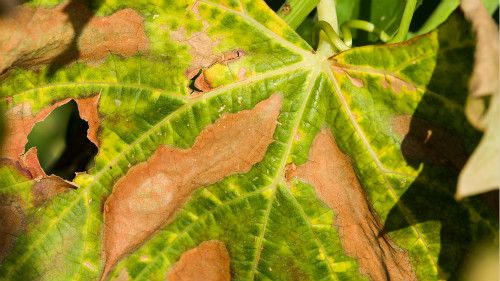Napa and Sonoma Vintners See a Surge in Vine-Killing Pierce's Disease
Date£º
2016-01-11 15:17 Source£º
WineSpectator.com Author:
Lynn Alley Translator:
Thousands of vines were uprooted in 2015, raising fears that warm weather is allowing the disease to spread.Leaves of vines infected by Pierce's disease yellow and die as the illness chokes the vine of nutrients.

Photo by: Thinkstock/Mazzo19
Two of California's most prominent wine regions experienced a surge in the vine-killing illness Pierce's disease in 2015, possibly the result of recent warmer winter conditions. Viticulture experts in both Napa and Sonoma counties report a significant increase in the number of vines being pulled up and destroyed due to Pierce's last year, including in areas where they haven't seen the disease before, raising anxiety levels (and financial pain) among local vintners.
There's been a "huge increase in traditional hotspots and in sites not normally affected," said Rhonda Smith, the University of California Cooperative Extension's (UCCE) viticulture advisor for Sonoma County.
Pierce's disease is caused by Xylella fastidiosa, a bacterium that comes in multiple strains and poses a threat to more than 200 types of plants, including grapevines and many fruit trees. The bacterium spreads easily and quickly, entering the plants with the help of insects.
Various subspecies of xylella attack different plants, travel on different insects and cause different diseases. The strain behind Pierce's disease, which forms a gel in vines' xylem, choking the plants of nutrients, originated in the southern U.S. The illness began to spread rapidly through California vineyards in 1996, thanks to the arrival of the glassy-winged sharpshooter, a non-local insect. Since then, vintners have labored to keep various sharpshooters away from their vines. The recent spread appears to be due to blue-green sharpshooters.
According to Smith, Sonoma County vintners have uprooted and destroyed thousands of vines this year, mostly due to increasing infections of Pierce's. She says that the Russian River Valley and Dry Creek areas have been hardest hit, but the problem is neither countywide nor appellation-wide. "Sites that have been hit hard in the past are the areas most severely impacted this year," she said. "But there are some sites not usually affected that have also been hit hard." She says the outbreak has been sporadic in its spread.
Smith noted that the worst problems seem to be in areas with the warmest winters, usually along the Russian River or one of the numerous small creeks that feed into the river, such as Dry Creek.
Growers in Napa County are seeing a similar patchwork pattern of vineyards and areas affected. Monica Cooper, Napa County's UCCE viticulture advisor, said that while "there's been a marked increase in the incidence of Pierce's here, especially in those blocks that normally have it, there are many areas, particularly areas along the riverbeds where they've done habitat restoration" that have had little problem. In the past, non-native plants along riverbanks have acted as reservoirs for xylella, allowing it to remain in the region even after infected vines are destroyed.
Other areas of the state have seen little or no increase in the incidence of Pierce's this year¡ªpartially because they have endured tougher drought conditions. "The more lush river system in Napa and Sonoma counties has plenty of areas to serve as reservoirs for both the bacteria that causes Pierce's and its vectors," said Larry Betiga, UCCE viticulture advisor for Monterey, Santa Cruz, Santa Clara and San Benito counties. "We don't have blue-green sharpshooters in Monterey County."
The Temecula Valley, once a serious hotbed of Pierce's, has also experienced no changes in levels of Pierce's this year, according to the Temecula Valley Winegrowers Association.
Scientists and growers are still somewhat puzzled about the complicated set of factors that contribute to these outbursts of Pierce's activity around the state. In an effort to solve the problem, the California Department of Food and Agriculture's Pierce's/GWSS board has just funded a three-year study to investigate the causes of Pierce's outbreaks. The research team will be headed by Dr. Rodrigo Almeida, an entomologist and Pierce's expert at U.C. Berkeley.
As yet, there is no method for preventing or curing Pierce's disease. In the meantime, said Cooper, "The most effective thing you can do to prevent the problem in our area is to remove alternate hosts." Those hosts are the plants that can harbor the bacterium.